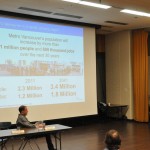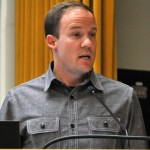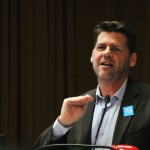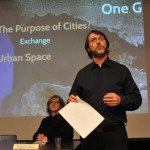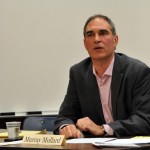The Mayors’ Council has a responsibility to plan for a regional transportation system that moves people and goods and supports environmental objectives and regional economic development. The system must also support Metro Vancouver’s Regional Growth Strategy, which projects that the region will grow by one million people by 2041 – from Elections BC information pamphlet.
A subcommittee of APAG – Priority 5 organized two events regarding the Metro Vancouver Transportation and Transit Plebiscite.
- Register to vote before May 15, 2015
- Voting closes May 29, 2015
At the first event on Wednesday March 11, Lon LaClaire, Manager of the City of Vancouver’s Strategic Transportation Planning Branch and Jim Bailey, Senior Planner with the City of Vancouver examined the need for the Broadway extension of the Millennium SkyTrain.
At the second event on Wednesday March 18, a panel of Langara College faculty examined issues related to the plebiscite.
Frances Bula, urban affairs writer, columnist and Department Chair of Journalism, examined the history behind TransLink and the plebiscite. TransLink is unique among transit authorities: it also has responsibility for roads and bridges. When TransLink was created in 2000, the Province of BC exempted Metro Vancouver residents from the hospital tax. Most of TransLink’s current funding comes from transit fares, property taxes, and a 17¢ gasoline tax.
The plebiscite is Canada’s first in 70 years. Several US cities have recently used referenda to decide on transit improvements. Los Angeles passed transportation referenda in 2008 & 2012 but Atlanta’s referendum in 2012 failed to pass.
Colin Mills of the Geography Department examined the purpose of cities and the use of urban space. Cities require both movement space such as roads and exchange space to facilitate the exchange of money, products, ideas, and relationships. But, there is a trade-off; more movement space reduces exchange space and increases the distance between exchange places. Furthermore, automobile use requires more movement space than other transportation modes such as buses and bicycles.
- Colin shares his Prezi presentation
Further population growth in Metro Vancouver may lead to more traffic congestion, lower population density through further increases in suburban residents, more greenhouse gas emissions, longer commutes, higher personal and municipal government costs, and diminished quality of life.
Murray Mollard, lawyer, former Executive Director of the BC Civil Liberties Association and instructor in Langara College’s Criminal Justice Program, spoke about efforts to establish a Citizens’ Assembly to investigate transit funding and the importance of younger Canadians in exercising their right to vote.
- Elections BC has more information
Register to vote before May 15, 2015 - Voting closes May 29, 2015

